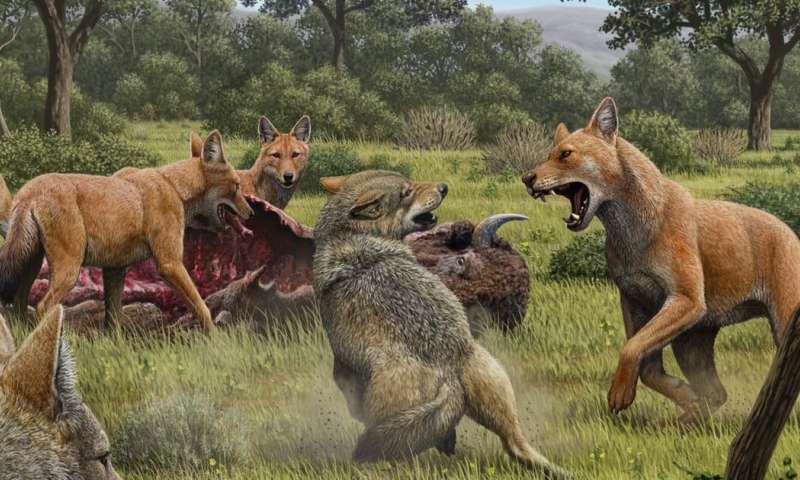Dire wolves went extinct 13,000 years ago but thanks to new genetic analysis their true story can now be told

Thanks to the hit television series Game of Thrones, the dire wolf has gained a near-mythical status. But it was a real animal that roamed the Americas for at least 250,000 years, until it became extinct towards the end of the last ice age around 13,000 years ago. While in popular culture the dire wolf is portrayed as a giant predator hunting in snow-covered, northern landscapes, most scientists instead agree that the dire wolf was a very close cousin of the gray wolf – the living species from which the dog was domesticated.
Our research published in the journal Nature shows that both of these characterisations are mistaken. For the first time, we were able to sequence ancient DNA from remains of the now-extinct dire wolf, providing surprising new insights into its origins and biology.
In addition to the gray wolf there are eight related wolf-like species alive today, including the coyote, African wild dog, and three species of jackal. We originally expected our genetic data to confirm what was already known based on looking at the size and shape of their bones: the dire wolf was just a large gray wolf or a very close relative.
Instead, by comparing dire wolf DNA to that of living species we found that the dire wolf belonged to an unknown 6 million year-old lineage, which was no more closely related to gray wolves than to jackals or the African wild dog. This suggests that the resemblance between dire and gray wolves may have only been skin deep—or bone deep, strictly speaking.
Evolving depictions of the dire wolf
In contrast to its depiction in Game of Thrones, the fossil record of the dire wolf shows it actually lived in temperate or tropical areas of the Americas. The gray wolf on the other hand is often found in the Arctic or other high-latitude areas, and all those in North America today descend from a single colonization around 20,000 years ago. In evolutionary terms, this means the two species may have only encountered each other relatively recently.
Though dire and gray wolves then shared the same environment for thousands of years, our new genetic data revealed that they did not interbreed. This was surprising, given that interbreeding between wolf-like species tends to be a rule rather than the exception. We concluded that the dire wolf must have been geographically isolated for a long time to build up such a pronounced biological difference that it could no longer interbreed with the gray wolf when they met again in North America.
The science suggests we should imagine the dire wolf as a very different animal to the gray wolf. When the two species did finally meet, they are likely to have already evolved very different behaviours, diets and appearances. Although we have no evidence about soft tissues or hair colour, palaeoartist Mauricio Antón represented them in the picture at the top of this article as more like a giant dhole (a wolf-like animal found in Asia), with short, reddish hair and larger ears for improved thermoregulation.
Fate of a unique lineage
So why did the dire wolf disappear, but not the gray wolf or other wolf-like species?

Most scientists agree that the dire wolf specialised in hunting large herbivores, many of which—including horses, bison and camels—became extinct or drastically declined in North America around 13,000 years ago. The disappearance of their prey almost certainly drove the dire wolf extinct. In contrast, the more flexible and adaptable gray wolf can survive on a greater variety of food sources.
Our new results help to explain these observations by showing that dire wolves probably evolved to become specialised over millions of years, meaning it was likely to have been very hard for them to adapt to rapid changes in their environment and prey. Plus, while some animal species—like the gray wolf—can sometimes evolve new adaptations after interbreeding with related species, this apparently wasn't possible for the dire wolf.
In the end, our results highlight just how much biological diversity has been lost in the recent past, as no living members of the dire wolf lineage now survive. The dire wolf thus represents yet another cautionary tale about how vulnerable specialised species are to rapid environmental changes, such as those driven by climate change or invasive species.
This story is part of Science X Dialog, where researchers can report findings from their published research articles. Visit this page for information about ScienceX Dialog and how to participate. This article is republished from The Conversation under a Creative Commons license. Read the original article.![]()